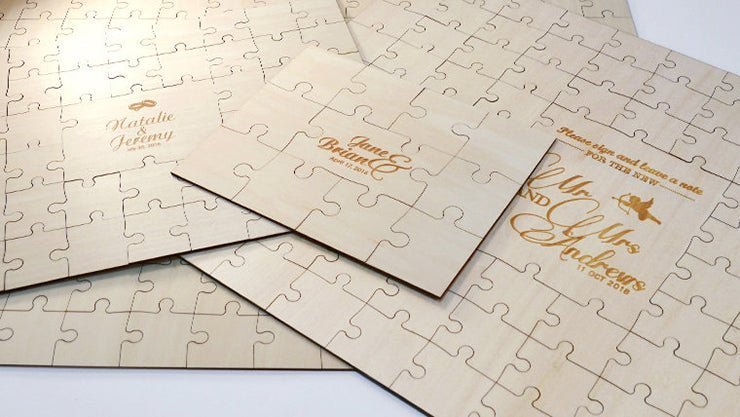Puzzle with engraving

Very nice as a gift to give, receive, or make yourself: puzzles. In this tutorial, we explain how you can create your own puzzle with a personal touch. The puzzle is fully customizable in scale and number of pieces.
Fortunately, we don't have to draw each piece by hand, but we use an open-source program that does this work for us. All you need to make this puzzle is a program where you can work with vector drawings such as Adobe Illustrator, AutoCAD, or Inkscape.
Preparation
Before you start designing, it's important to think about what should be on the puzzle and how large it should be. It is possible to engrave photos, but a regular .png or .jpg must first be prepared. For this, you can follow the photo engraving tutorial .
If you have a vector drawing (.ai, .svg, .dxf, etc.) you can proceed directly to the next step. No additional steps need to be taken.
Designing Puzzle Pieces
To design the puzzle pieces, we use a free online program that generates the puzzle pieces. Of course, it is also possible to draw the puzzle pieces yourself, but this requires a bit more time and effort.
There are numerous online programs to create puzzles, we use "Jigsaw Puzzle". This program is quite simple but has all the necessary functionalities. On the webpage, you can enter a number of parameters, each option is described below.
- Seed: A number on which the randomness of the puzzle is based, this does not need to be changed but can be altered if you are not satisfied with the current appearance of the puzzle.
- Tab size: Size of the protrusions on each piece, the standard value is sufficient for most puzzles, but can be increased if desired
- Jitter: "Mobility" of the protrusions on each piece, the higher the value, the easier the puzzle. Note that at higher values, watch out for (almost) crossing cut lines.
- Tiles: Number of pieces horizontally and number of pieces vertically.
- Size: Size of the puzzle, which can be scaled later. It is advisable to choose a number that is divisible by the number of pieces in the respective direction on both axes. For example: 12x6 puzzle pieces = 600x300mm or 15x10 puzzle pieces = 500x300mm. This is not necessary but does result in the most uniform puzzle pieces. It is also useful if the puzzle somewhat matches the aspect ratio of the drawing that needs to be placed on it.
Once the puzzle is made to your liking, it can be saved by clicking the "download svg" button. The file can be saved to a desired location and then opened in Adobe Illustrator
Engraving on the puzzle
Now that the puzzle is opened in Adobe Illustrator, the first task is to make the lines as thin as possible. Select everything using ctrl+a and change the thickness to 0.25mm. If your puzzle is very large, you probably won't see the lines or will barely see them when you zoom out. This is not a problem, our software does see the lines. If you prefer to see the lines during the design, you can also make the lines thin as the last step.
Depending on whether you want to engrave a photo or a vector drawing, the next step is different.
Engrave vector drawing (.svg, .ai, .eps etc.<|vq_10892|>)
This is the easiest way to make a puzzle, as the machine recognizes the different parts of the drawing, unlike with a photo.
Open your design in a new Illustrator document and ensure that all parts of the drawing are formatted according to the drawing rules. Copy the drawing to the puzzle and place it over it. If the drawing extends beyond the edge, the drawing can be resized so that the puzzle can accommodate the drawing, or the protruding parts can be removed by trimming them at the edge.
Photo engraving (.jpeg, .png etc.)
Ensure that you have followed all the steps in the photo engraving tutorial !
Open your photo in the same document as the puzzle in Illustrator. Then place it over the puzzle and enlarge/reduce the photo if necessary.If the photo extends beyond the edge of the puzzle, this is not a problem, but we do recommend cropping the photo in an external photo editing program to avoid unnecessary costs.
Unfortunately, our online app cannot automatically recognize cut files with photos. If you are using a photo on the puzzle, you can request a quote.
Puzzling!
Upload your drawing, choose the material, check out, and we will do the rest. Birch plywood is a beautiful, sturdy wood type for the puzzle pieces, but you can of course also choose another type of wood or even plastic. We advise using protective film on both sides of the material.




